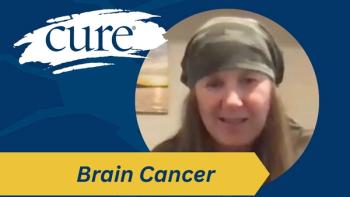
Expert Talks Molecular Targets in Lung Cancer
“The goal is to identify more of these driving genetic alterations and to come up with treatments that we can target,” said Das in an interview during an interview with CURE.
Millie Das, MD
While the majority of patients with non-small cell lung cancer (NSCLC) do not have known molecular drivers, studies are investigating treatment protocols that could improve efficacy for treating these patients, says Millie Das, M.D.
For example, the ongoing ECOG E-5508 trial is studying Avastin (bevacizumab) and pemetrexed disodium alone or in combination following induction therapy with carboplatin/paclitaxel/ Avastin to determine whether outcomes are improved in treating patients with advanced nonsquamous NSCLC (
Additionally, next-generation sequencing platforms are evolving to detect some of the less-common molecular alterations in patients without EGFR, ALK or ROS1 drivers—including HER2,BRAF and RET.
“The goal is to identify more of these driving genetic alterations and to come up with treatments that we can target,” said Das in an interview during an interview with CURE.
What did you highlight regarding these patients with non-driver NSCLC?
How do you currently use Avastin? Can you use it in both the frontline and maintenance settings for a patient?
Das, a clinical assistant professor of medicine — oncology at Standard Medicine, explained the difficulties of the non-driver NSCLC patient population, interesting clinical trials that could reshape therapeutic options, and her belief that these patients do have molecular targets that have yet to be identified.I discussed the treatment options for the majority of our patients who actually don’t have known driver genetic alterations. I talked about the data for chemotherapy and targeted agents—pemetrexed as a frontline option, but also as a maintenance option for our patients. I reviewed the data for Avastin, as well, to look at it in the frontline and maintenance settings, and touched upon some of the recent data with Portrazza (necitumumab) and Cyramza (ramucirumab) that have gained FDA approval in the treatment of lung cancer. For Avastin, the main thing is the patient selection. In the upfront setting, you would want to think about it for patients with good performance status. We know that the ECOG E-4599 study that looked at Avastin examined it in ECOG performance score 0 and 1 patients. These are really fit and likely younger patients. We know that, with patients over the age of 70, there is a higher risk of toxicity—so you want to be mindful of that. For patients who are having ongoing hemoptysis, you’re not going to want to offer that.
Are there combination regimens being explored with Avastin?
Again, patient selection plays a very important role. [You need to be] talking to the patient about the additional benefit with the addition of Avastin to standard chemotherapy, discussing the increased risks and the benefits, and involving them in the decision to add that as part of their treatment strategy. That is an area of ongoing interest and research. The ECOG E-5508 study is looking to see whether the combination of pemetrexed and Avastin as maintenance treatment after upfront treatment with carboplatin/paclitaxel/Avastin is any better than maintenance Avastin alone or maintenance pemetrexed alone. That will be a really interesting study to see what that shows in the end.
What are your guidelines for maintenance therapy?
Can you highlight activity seen with Portrazza and Cyramza?
For patients who have started on treatment with carboplatin/pemetrexed/Avastin, it is very reasonable to continue them on the pemetrexed/Avastin maintenance. Again, [you need to be] sitting down with the patient, having a discussion, and talking about how they’re doing with the treatment. Some patients are just glad to be done with their upfront therapy and don’t want to be coming in every three weeks, especially if transportation or distance is an issue. You can talk to them about whether this is something they would want to pursue or if they would rather have a break. It is generally for as long as the patients are tolerating it and as long as the treatment is working. I’ll continue to get surveillance imaging every two or three months, and you’ll obviously be seeing the patient every time they’re coming in for infusions. If they’re starting to develop toxicities, then I’ll have a low threshold to stop that treatment and give patients a break. Certainly, if there is disease progression, you are going to want to stop that and talk about next treatment options. The SQUIRE study looked at the addition of Portrazza to standard cisplatin/gemcitabine in patients with squamous lung cancer, and it did show a survival benefit with the addition of Portrazza; it did lead the FDA to approve this drug.
This non-driver population is the majority of patients with NSCLC. What does the future of this landscape look like to you?
I personally have had a little bit of trouble adding this drug to my patients with squamous cell lung cancer because they do tend to be older and sicker, so just standard chemotherapy is not easy for them—and then, when you’re adding on an additional agent, it can be tough. As we move forward, the major goal here is to continue to identify the driving genetic alterations. Of course, we have the EGFR-mutant and the ALK-positive patients. However, we have recently been able to discover BRAF, HER2, and other driver genetic alterations that we might see mutated in other malignancies. We are seeing that in lung cancer and it is pretty exciting.
We know that the FDA recently approved the combination of Mekinist (trametinib) and Tafinlar (dabrafenib) in patients with BRAF-mutated lung cancer, so that is where we are really headed toward. We will probably not be offering patients systemic intravenous chemotherapy, when we can actually provide them with a targeted drug.
We know that KRAS is commonly mutated in lung cancer, but we don’t yet have a drug that’s effective specifically for patients with KRAS-mutant lung cancer. Hopefully, we will develop that in the next 10 years. We could be able to offer that patient with a KRAS mutation a targeted treatment upfront rather than chemotherapy.




